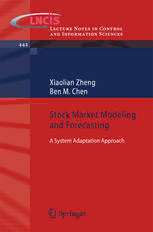
Stock Market Modeling and Forecasting: A System Adaptation Approach PDF
Preview Stock Market Modeling and Forecasting: A System Adaptation Approach
LLeecctture Notes in Control and Information Sciences 442 Xiaolian Zheng Ben M. Chen Stock Market Modeling and Forecasting A System Adaptation Approach 123 Lecture Notes in Control and Information Sciences 442 Editors ProfessorDr.-Ing.ManfredThoma InstitutfuerRegelungstechnik,UniversitätHannover,Appelstr.11,30167Hannover, Germany E-mail:[email protected] ProfessorDr.FrankAllgöwer InstituteforSystemsTheoryandAutomaticControl,UniversityofStuttgart, Pfaffenwaldring9,70550Stuttgart,Germany E-mail:[email protected] ProfessorDr.ManfredMorari ETH/ETLI29,Physikstr.3,8092Zürich,Switzerland E-mail:[email protected] SeriesAdvisoryBoard P.Fleming UniversityofSheffield,UK P.Kokotovic UniversityofCalifornia,SantaBarbara,CA,USA A.B.Kurzhanski MoscowStateUniversity,Russia H.Kwakernaak UniversityofTwente,Enschede,TheNetherlands A.Rantzer LundInstituteofTechnology,Sweden J.N.Tsitsiklis MIT,Cambridge,MA,USA Forfurthervolumes: http://www.springer.com/series/642 Xiaolian Zheng and Ben M. Chen Stock Market Modeling and Forecasting A System Adaptation Approach ABC XiaolianZheng BenM.Chen DepartmentofElectricaland DepartmentofElectricaland ComputerEngineering ComputerEngineering NationalUniversityofSingapore NationalUniversityofSingapore Singapore Singapore ISSN0170-8643 ISSN1610-7411 (electronic) ISBN978-1-4471-5154-8 ISBN978-1-4471-5155-5 (eBook) DOI10.1007/978-1-4471-5155-5 SpringerLondonHeidelbergNewYorkDordrecht LibraryofCongressControlNumber:2013936055 (cid:2)c Springer-VerlagLondon2013 Thisworkissubjecttocopyright.AllrightsarereservedbythePublisher,whetherthewholeorpartof thematerialisconcerned,specificallytherightsoftranslation,reprinting,reuseofillustrations,recitation, broadcasting,reproductiononmicrofilmsorinanyotherphysicalway,andtransmissionorinformation storageandretrieval,electronicadaptation,computersoftware,orbysimilarordissimilarmethodology nowknownorhereafterdeveloped.Exemptedfromthislegalreservationarebriefexcerptsinconnection with reviews or scholarly analysis or material supplied specifically for the purpose of being entered and executed on a computer system, for exclusive use by the purchaser of the work. Duplication of this publication or parts thereof is permitted only under the provisions of the Copyright Law of the Publisher’slocation,initscurrentversion,andpermissionforusemustalwaysbeobtainedfromSpringer. PermissionsforusemaybeobtainedthroughRightsLinkattheCopyrightClearanceCenter.Violations areliabletoprosecutionundertherespectiveCopyrightLaw. Theuseofgeneraldescriptivenames,registerednames,trademarks,servicemarks,etc.inthispublication doesnotimply,evenintheabsenceofaspecificstatement,thatsuchnamesareexemptfromtherelevant protectivelawsandregulationsandthereforefreeforgeneraluse. Whiletheadviceandinformationinthisbookarebelievedtobetrueandaccurateatthedateofpub- lication,neithertheauthorsnortheeditorsnorthepublishercanacceptanylegalresponsibilityforany errorsoromissionsthatmaybemade.Thepublishermakesnowarranty,expressorimplied,withrespect tothematerialcontainedherein. Printedonacid-freepaper SpringerispartofSpringerScience+BusinessMedia(www.springer.com) To MyParents X. Zheng To MyGranduncle,Paul,andMyDad, Joseph B. M.Chen Preface Inrecentdecades,modelingoffinancialmarketshasarousedgreatinterestsinthe academiaandinthefinancialindustryworldwide.Financialmarketisahighlycom- plex system involvinga large numberof interacting factors ranging from psycho- logical, social and politicalaspects to generaleconomicperformance.There is no conclusiveknowledgeoftheinfluenceofthesefactorsandthecorrespondingmarket responses,eventhepublicopinionsondecisivefactorstoaparticularfinancialevent are usuallydiversified.The financialmarketis also knownforits noisydata, non- linearityanddynamicbehavior,allofwhichmakeitsmodelingextremelydifficult. These challengescall for a comprehensivestudy of the market behavior. Systems theory provides a totally different angle to investigate financial market modeling problems by analyzing the market as a complex system. It is a powerful tool in studying the interconnections and interactions inside the market and between the marketanditsenvironment.Aframeworkthatcombinesvariousfoundationsofboth systemsconceptsandfinancialmarketscanthusprovidemoremeaningfulinsights intomarketbehaviors. Thismonographaimstodevelopageneralframeworkormodelstructurebased onsystemstheorytodepictandanalyzethefinancialmarkets,inparticularthestock markets,andtoprovideaccuratepredictionsofmarketpricesandmajormarketre- visions,i.e.,turningperiods.Theframeworkiscarefullydesignedtoconsiderboth internalcharactersofthemarketandexternalinfluentialfactors,andthusiscapable ofcapturingdifferenttypesofmarketdynamicsandbehaviors.Thestructureofthe frameworkand the processingof informationinside and outsidethe marketare to beaddressedindetail.Theapplicationsofourframeworkinfindingfeaturesinthe stockmarketsfromtheU.S.,China,HongKong,andSingapore,examplesofboth developedandemergingmarkets,aregivenandanalyzed.Someinterestingobser- vationsrelatedtoourframeworkandresults,andpossiblefutureresearchdirections thatwouldfurtherextendourstudyandunderstandingofthestockmarket,arealso tobehighlighted. Theintendedaudienceforthismonographincludesgraduatestudents,researchers inareasrelatedtofinancialmodelingandanalystsinfinancialsectors.Itisassumed VIII Preface thatthereaderhassomepreviousknowledgeinfinancialmodelingandstatisticsas wellasinbasicsystemstheory. Theauthorshavebenefitedagreatdealfrommanyfruitfuldiscussionswithour colleagues and research teammates at the National University of Singapore. Par- ticularly, we would like to thank Dr. Nan Jiang, Dr. Feng Lin, Mr. Limiao Bai, Professor Delin Chu, Professor Qing-Guo Wang and Professor Cheng Xiang for their valuable commentsand help duringthe course of studies and preparation of this monograph. We are also indebted to Dr. Sen Yan of Xiamen University, Ms. JieZhengofRiceUniversity,Dr.ShanleWuofUBSAGandDr.LichaoChengof China Life Asset ManagementCompanyfortheir insightfulsuggestionsand their generousassistance. This monographwas typeset by the authors using LATEX. All simulations, case studiesandnumericalcomputationswerecarriedoutin MATLAB.Diagramswere generatedusingXFIGandMATLABwithSIMULINK. KentRidge,Singapore XiaolianZheng BenM.Chen Contents 1 Introduction................................................... 1 1.1 Introduction ............................................... 1 1.2 StockMarketAnalysis ...................................... 4 1.3 ContributionofThisWork ................................... 7 1.4 PreviewofEachChapter .................................... 9 2 ASystemAdaptationFramework................................ 13 2.1 Introduction ............................................... 13 2.2 StructureofSystemAdaptationFramework..................... 14 2.3 InternalModelDesign ...................................... 17 2.4 AdaptiveFilterDesign ...................................... 20 2.5 CaseStudy:DowJonesIndustrialAverage ..................... 24 2.5.1 DataDescription..................................... 25 2.5.2 InternalModelEstimation............................. 25 3 MarketInputAnalysis.......................................... 29 3.1 Introduction ............................................... 29 3.2 InfluentialFactorSelection .................................. 30 3.2.1 CausalityTests ...................................... 31 3.2.2 RedundantVariableTest .............................. 35 3.3 InfluentialFactorsofDowJonesIndustrialAverage.............. 35 3.3.1 EmpiricalSelection .................................. 35 3.3.2 Time-VaryingCausalityTestResults .................... 37 3.3.3 NonlinearCausalityTestResults ....................... 42 3.3.4 RedundantVariableTestResults ....................... 42 4 AnalysisofDowJonesIndustrialAverage......................... 43 4.1 Introduction ............................................... 43 4.2 MeasureofPredictingPerformance ........................... 44 4.3 AdaptiveFilterandPredictingPerformance..................... 45 4.3.1 PreliminaryAnalysis ................................. 45 X Contents 4.3.2 AdaptiveFilterHyperparameters ....................... 47 4.3.3 PredictingPerformance ............................... 48 5 SelectedAsianMarkets ......................................... 53 5.1 Introduction ............................................... 53 5.2 ShanghaiStockExchangeCompositeIndex .................... 53 5.2.1 InputSelection ...................................... 54 5.2.2 CausalityTests ...................................... 57 5.2.3 PredictingPerformanceandAnalysis ................... 63 5.3 HongKongHangSengIndex ................................ 65 5.3.1 InputSelection ...................................... 66 5.3.2 CausalityTests ...................................... 68 5.3.3 PredictingPerformanceandAnalysis ................... 74 5.4 SingaporeStraitsTimesIndex................................ 78 5.4.1 InputSelection ...................................... 78 5.4.2 CausalityTests ...................................... 80 5.4.3 PredictingPerformanceandAnalysis ................... 86 6 MarketTurningPeriodForecasting .............................. 91 6.1 Introduction ............................................... 91 6.2 AFrequencyDomainForecastingTechnique ................... 92 6.2.1 DowJonesIndustrialAverage.......................... 95 6.2.2 China,HongKongandSingaporeMarkets...............102 6.3 ASystemStability-BasedConfirmationMethod.................111 6.3.1 DowJonesIndustrialAverage..........................116 6.3.2 HongKongHangSengIndex ..........................116 6.3.3 SingaporeStraitsTimesIndex .........................118 6.3.4 ShanghaiStockExchangeCompositeIndex..............118 7 TechnicalAnalysisToolkit.......................................123 7.1 Introduction ...............................................123 7.2 T-TASFunctions ...........................................125 7.2.1 UserandDataManagement ...........................125 7.2.2 OnlineDataLoadingSystem ..........................127 7.2.3 TechnicalAnalysis...................................129 7.2.4 SystemAdaptationFramework.........................143 8 FutureResearch ...............................................149 References.........................................................151 Index .............................................................159 Abbreviations AIC AkaikeInformationCriterion ANN ArtificialNeuralNetwork AMH AdaptiveMarketHypothesis AR Autoregressive ARCH AutoregressiveConditionalHeteroscedasticity ARIMA AutoregressiveIntegratedMovingAverage ARMA AutoregressiveMovingAverage ARMAX AutoregressiveMovingAverageModelwithExogenousInput BDI BalticDryIndex CAPM CapitalAssetPricingModel CBOE ChicagoBoardOptionsExchange CBR CaseBasedReasoning CNY ChineseYuan CPI ConsumerPriceIndex DJIA DowJonesIndustrialAverage DEFFR DailyEffectiveFederalFundsRate EIU EconomistIntelligenceUnit EMA ExponentialMovingAverage EMH EfficientMarketHypothesis EUR/JPY EuroversusJapaneseYen FFFR FederalFundsFutureRate FFR FederalFundsRate FFRT FederalFundsRateTarget FFT FastFourierTransform FMH FractalMarketHypothesis FTSE FinancialTimesandStockExchange GARCH GeneralizedAutoregressiveConditionalHeteroskedasticity GDP GrossDomesticProduct GUI GraphicalUserInterfaces GUIDE GUIDevelopmentEnvironment HKAB HongKongAssociationofBanks
